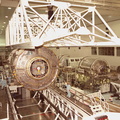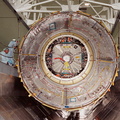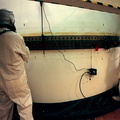
WIKIARCHIVES.SPACE
The Human Spaceflight Archive

Information
- Taken in
- Kennedy Space Center
- Author
- NASA
- Description
- In the Space Station Processing Facility, the U.S. Laboratory Destiny, a component of the International Space Station, glides overhead other hardware while visitors watch from a window (right). On the floor, left to right, are two Multi-Purpose Logistics Modules (MPLMs), Raffaello (far left) and Leonardo, and a Pressurized Mating Adapter-3 (right). Destiny is being moved to a payload canister for transfer to the Operations and Checkout Building where it will be tested in the altitude chamber. Destiny is scheduled to fly on mission STS-98 in early 2001. During the mission, the crew will install the Lab in the Space Station during a series of three space walks. The STS-98 mission will provide the Station with science research facilities and expand its power, life support and control capabilities. The U.S. Lab module continues a long tradition of microgravity materials research, first conducted by Skylab and later Shuttle and Spacelab missions. Destiny is expected to be a major feature in future research, providing facilities for biotechnology, fluid physics, combustion, and life sciences research.
- Created on
- Tuesday 27 June 2000
- Albums
-
Locations / OSM-4.915832801313164
US SPACE PROGRAM / SPACE SHUTTLE / MISSIONS / STS-98 / Rocket preparation
- Source link
- https://science.ksc.nasa.gov/gallery/photos/2000/
- Visits
- 43
- Rating score
- no rate
- Rate this photo
- License
- CC BY-NC-ND
- Modified by WikiArchives
- No (original)
- Downloads
- 0
Powered by Piwigo













